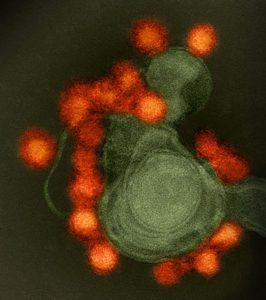
Transmission electron microscope image of negative-stained, Fortaleza-strain Zika virus (red), isolated from a microcephaly case in Brazil. (NAID, Wikimedia Commons)
Knowledge of Zika virus (ZIKV) immunity in the genital tract is limited. Researchers from Washington University in USA aimed to determine if subcutaneous ZIKV infection protects against intravaginal ZIKV challenge, as well as determine components of the immune system that contribute to protective immunity in the genital tract.
Aedes sp. mosquitoes were thought to be the only mode of ZIKV transmission. Consequently current research primarily aims at understanding systemic correlates of protection against ZIKV infection. Recently studies have shown that human to human transmission primarily via the sexual route can occur. Additionally, animal models have shown a 50% rate of ZIKV transmission from ZIKV infected male mice to naïve female mice. However, few studies have characterised immune responses following sexual ZIKV transmission, or immune responses in the genital tract.
Unlike in humans, ZIKV infection in mice does not block type I IFN signalling, thus to mimic characteristics of human ZIKV infection in mice, all experiments were performed in the presence of blocking anti-IFNAR1 antibody. This allowed them to demonstrate ZIKV infection following intravaginal inoculation disseminates to the upper female reproductive tract only when type I IFN signalling is blocked. Using a secondary challenge model they showed that both primary intravaginal or subcutaneous challenge protected mice from secondary intravaginal challenge. This suggests that ZIKV induced immunity following infection from Aedes sp. can protect individuals from sexually transmitted ZIKV.
Scott et al., showed that either mode of ZIKV infection (intravaginal vs subcutaneous) resulted in enrichment of CD4+ and CD8+ T cells in the vagina and uterine horn. Surprisingly, an increase in ZIKV-specific antibodies levels in the female genital tract following ZIKV infection was not associated with recruitment of B cells to the genital tract. Additionally, they showed that ZIKV (tetramer)-specific CD8+ T cells in the vaginal were predominantly tissue resident memory cells, determined by expression of CD103. However, ZIKV-specific CD8+ T cells in the uterine horn were predominantly CD103-. Suggesting that either CD103 is not a reliable marker T cells tissue resident memory cells in uterine tissue or majority of ZIKV-specific CD8 T cells in uterine tissue are predominantly effector cells.
Finally, they illustrated that neither cellular (CD4 and CD8 T cells) nor humoral immunity is solely responsible for ZIKV protective immunity in the female reproductive tract, where in the absence T cells, B cells were able to control infection and vice versa. This may suggest that innate immunity may play an essential role in immunity against ZIKV, more studies are required to confirm this. Though CD4 T cells were not essential CD4+ T cells for humoral immunity, they did contribute to improved humoral immunity.
Journal Article: Scott et al., 2018. Cellular and Humoral Immunity Protect against Vaginal Zika Virus Infection in Mice. Journal of Virology
Article by Cheleka AM Mpande.











